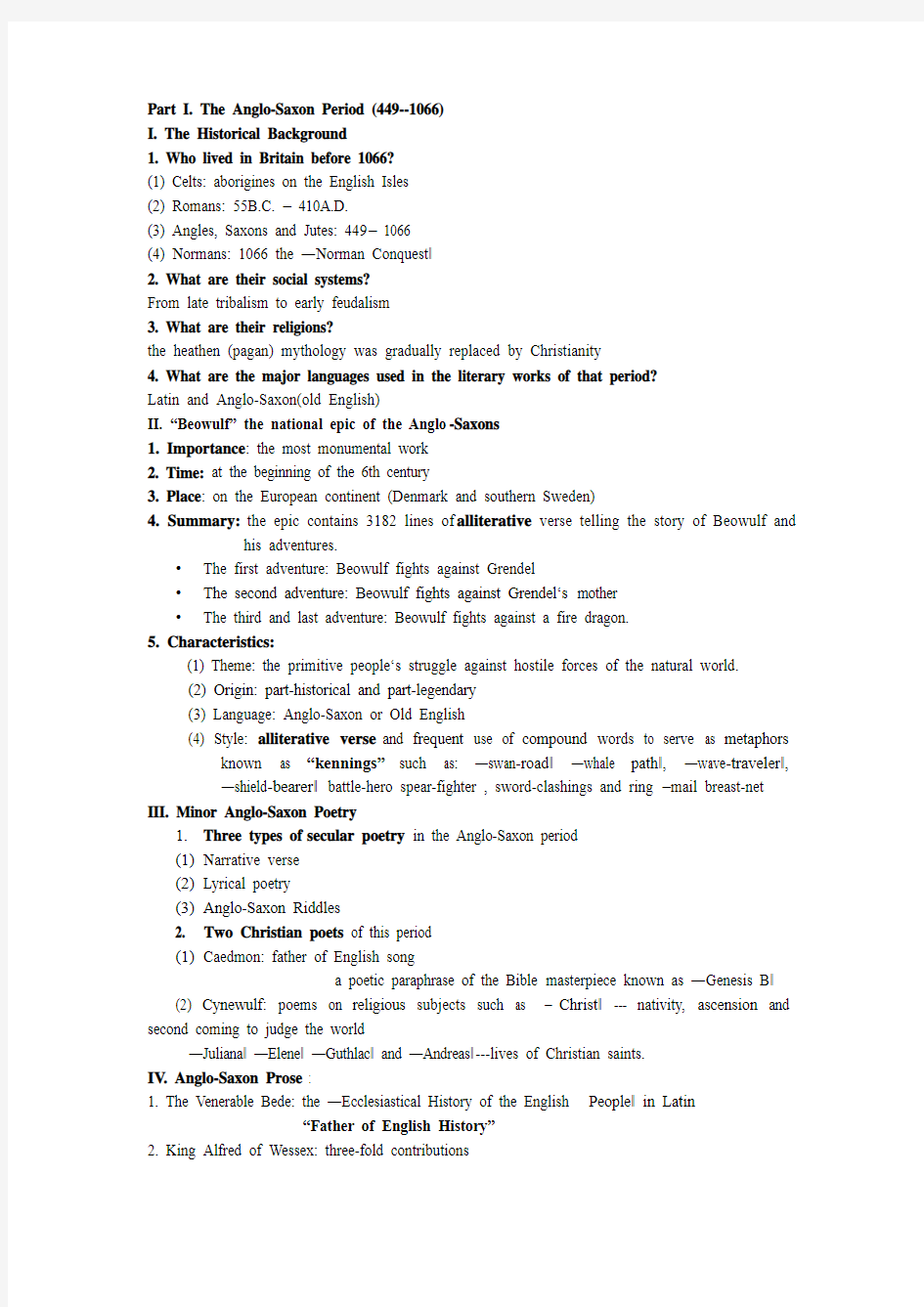英国文学1

- 1、下载文档前请自行甄别文档内容的完整性,平台不提供额外的编辑、内容补充、找答案等附加服务。
- 2、"仅部分预览"的文档,不可在线预览部分如存在完整性等问题,可反馈申请退款(可完整预览的文档不适用该条件!)。
- 3、如文档侵犯您的权益,请联系客服反馈,我们会尽快为您处理(人工客服工作时间:9:00-18:30)。
Part I. The Anglo-Saxon Period (449--1066)
I. The Historical Background
1. Who lived in Britain before 1066?
(1) Celts: aborigines on the English Isles
(2) Romans: 55B.C. – 410A.D.
(3) Angles, Saxons and Jutes: 449– 1066
(4) Normans: 1066 the ―Norman Conquest‖
2. What are their social systems?
From late tribalism to early feudalism
3. What are their religions?
the heathen (pagan) mythology was gradually replaced by Christianity
4. What are the major languages used in the literary works of that period?
Latin and Anglo-Saxon(old English)
II. “Beowulf” the national epic of the Anglo-Saxons
1. Importance: the most monumental work
2. Time: at the beginning of the 6th century
3. Place: on the European continent (Denmark and southern Sweden)
4. Summary: the epic contains 3182 lines of alliterative verse telling the story of Beowulf and
his adventures.
•The first adventure: Beowulf fights against Grendel
•The second adventure: Beowulf fights against Grendel‘s mother
•The third and last adventure: Beowulf fights against a fire dragon.
5. Characteristics:
(1) Theme: the primitive people‘s struggle against hostile forces of the natural world.
(2) Origin: part-historical and part-legendary
(3) Language: Anglo-Saxon or Old English
(4) Style: alliterative verse and frequent use of compound words to serve as metaphors
known as “kennings”such as: ―swan-road‖ ―whale path‖, ―wave-travel er‖,
―shield-bearer‖ battle-hero spear-fighter , sword-clashings and ring –mail breast-net III. Minor Anglo-Saxon Poetry
1.Three types of secular poetry in the Anglo-Saxon period
(1)Narrative verse
(2)Lyrical poetry
(3)Anglo-Saxon Riddles
2. Two Christian poets of this period
(1)Caedmon: father of English song
a poetic paraphrase of the Bible masterpiece known as ―Genesis B‖
(2) Cynewulf: poems on religious subjects such as ― Christ‖ --- nativity, ascension and second coming to judge the world
―Juliana‖ ―Elene‖ ―Guthlac‖ and ―Andreas‖---lives of Christian saints.
IV. Anglo-Saxon Prose :
1. The Venerable Bede: the ―Ecclesiastical History of the English People‖ in Latin
“Father of English History”
2. King Alfred of Wessex: three-fold contributions
(1)Numerous translations from Latin
(2)writing in a natural style in English
(3)organizing the compiling of ―Anglo-Saxon Chronicle‖(A.D. 1—A.D. 1154)
3. Aelfric: the greatest prose writer of his time
Exercises:
1. After the fall of the Roman Empire and the withdrawal of Roman troops from Albion , the aboriginal _____ population of the larger part of the island was soon conquered and almost totally exterminated by the Teutonic tribes of ____ , ____ , and _____ who came from the continent and settled in the island , naming its central part _____ , or England.
2. For nearly ____ years prior to the coming of the English , British had been a Roman province . In___, the Rome withdrew their legions from Britain to protect herself against swarms of Teutonic invaders.
3. The literature of early period falls naturally into two divisions,___ and ____.
4.____ can be justly termed England‘s natio nal epic and its hero ____ —one of the national heroes of the English people.
5. The Song of Beowulf reflects events which took place on the ____ approximately at the beginning of the ____ century , when the forefathers of the Jutes lived in the southern part of the ____ and maintained close relations with kindred tribes ,e.g. with the ____ who lived on the other side of the straits.
6. Among the early Anglo-Saxon poets we may mention ____ who lived in the half of the ____ century and who wrote a poetic Paraphrase of the Bible.
7. ____ is the first know religious poet of England . He is known as the father of English song.
8. The didactic poem The Christ was produced by ____ .
9. The most important work of ____ is the Anglo-Saxon Chronicles , which is regarded as the best monument of the old English prose.
a. Alfred the Great
b. Caedmon
c. Cynewulf
d. Venerable Bede
10. Who is the monster half-human who had mingled thirty warriors in The Song of Beowulf?
a. Hrothgat
b. Heorot
c. Grendel
d. Beowulf
11. ____ is the first important religious poet in English literature.
a. Gynewulf
b. Caedmon
c. Shakespeare
d. Adam Bede
12. The epic , The Song of Beowulf ,represents the spirit of ___.
a. Monks
b. romanticists
c. sentimentalists
d. pagan
13. Define the literary terms listed below.
1). Alliteration 2). Epic
14. Please give brief description of The Song of Beowulf.
Part II The Anglo-Norman Period (1066-1350)
I. Historical Background
1. Politically: the development of feudalism
2. Socially: the chief social conflict was between the serfs or peasants and their feudal lords
3. In terms of the languages
